How to Identify Accounts for ABM: A Step-By-Step Guide for B2B Marketing Teams
Learn a proven 7-step framework to identify, segment, and target high-value accounts for your B2B account-based marketing strategy.


“We need to be more targeted with our marketing strategy.”
It’s the directive you’ve probably heard from your CMO, your CEO, or your board. And they’re right – the days of casting wide nets and hoping for the best are over.
You can have the perfect messaging, the most engaging content, and flawless execution – but if you’re targeting accounts that will never buy from you, you’re just burning budget in style.
This is why account selection is the foundation of every successful account-based marketing strategy.
Get it right, and everything else (conversion rates, deal sizes, pipeline velocity) improves dramatically. Get it wrong, and even your best campaigns struggle to deliver.
In this guide, we’ll walk through exactly how successful B2B marketing teams identify and prioritize their target accounts – from building your initial ICP to leveraging intent data and predictive analytics.
Let’s start with the first step —
Define Your Ideal Customer Profile (ICP)
A well-defined Ideal Customer Profile (ICP) ensures your marketing and sales teams focus on high-value accounts that are most likely to convert, expand, and stay long-term.
Action plan:
Pinpoint Your Best Customers
Look at your highest-value customers, and find the ones with the best retention, expansion, and deal sizes. These accounts set the benchmark for what an ideal customer looks like.
You’ll find this data in:
- Closed-won deals with the highest lifetime value (LTV).
- Customers with fastest deal cycles and lowest churn.
- Accounts that generate the most repeat business and referrals.
Define Firmographics & Technographics.
Your best customers will share common business traits. Identify them to filter out low-fit accounts.
Key firmographic attributes:
- Industry. Which sectors see the most value from your solution?
- Company Size. SMB, mid-market, or enterprise?
- Revenue Range. Can they afford your solution?
- Growth Stage. Are they early-stage, scaling, or mature businesses?
- Location. Where is your ideal customer base concentrated? Are they primarily in specific regions or expanding into new markets?
Key technographic data attributes:
- Tech Stack. What tools do they already use?
- Compatibility. Do they integrate well with your solution?
- Software Maturity. Are they early adopters or still new in your space?
Identify Decision-Makers & Buying Committees
ABM is less about ‘leads’ and more about the buying committee. Even if an account fits your ICP, you need to engage the right stakeholders.
These are the roles to focus on:
- Decision-makers. Those who approve purchases (CMOs, CIOs, CFOs).
- Influencers. Those who evaluate solutions (Directors, Managers, Team Leads).
- End Users. Those who actually use the product.
Not every department will care about the same pain points, it’s best to tailor messaging accordingly.
Align ICP with Pain Points & Buying Behavior
An account that matches your firmographics but doesn’t have a problem you can solve is not a great fit.
Do this:
- Review past customer pain points: What problems did they solve with your product?
- Analyze lost deals: Were they missing urgency, budget, or internal buy-in?
- Check intent data: Are they actively researching similar solutions?
DB Insider → Build a “Non-ICP” list to disqualify poor-fit accounts immediately.
Common red flags include incompatible tech stacks, poor revenue potential, regulatory barriers, or industries with low adoption rates.
This saves precious time and resources early in the process.
Leverage First-Party Data to Identify High-Engagement Accounts
Your ICP tells you who to target, but before you look for new accounts, start with what you already have. Many high-potential customers are already engaging with your brand—you just need to surface them.
The best place to start is with your first-party data, i.e., your CRM, website traffic, and marketing engagement. This data reveals which accounts are showing interest before they even reach out.
Action plan:
Surface High-Value Accounts in Your CRM
Here’s what to look for:
- Previously engaged accounts that never converted.
- Past customers who might be ready for a cross-sell or upsell.
- Dormant opportunities that stalled due to timing, budget, or internal priorities.
Track Website Engagement for Buying Signals
Your website tells you who’s already researching your product. The more an account interacts, the higher its likelihood of converting. But not all visits are equal.
Track these intent signals:
- Pricing page visits: Strong indicator of interest.
- Product page engagement: Time spent and number of views.
- High-value content downloads: Whitepapers, case studies, or ROI calculators.
DB Insider → Implement a 90-day lookback rule to identify key accounts that engaged but didn’t convert.
Focus on those who visited high-intent pages (pricing, product) multiple times or downloaded premium content. These warm accounts often convert faster than cold outreach.

You can use Demandbase’s Engagement Minutes to track the level of interaction your target accounts have with your company. This includes responses to marketing programs, website visits, product usage, and conversations with the sales team.
Use Intent Data to Identify In-Market Accounts
Not all high-fit accounts are actively looking for a solution. Most B2B companies often start their research long before they reach out to vendors. And some might not even be aware of your brand yet. This is where you need intent data.
Intent data helps you identify which accounts are in-market, researching solutions like yours, and engaging with competitors.
Action plan:
Monitor Topic-Based Intent Signals
Certain companies increase their research activity before making a buying decision. Intent data providers track these surges across thousands of online sources.
Here’s what to track:
- Industry-specific content consumption: Are they reading articles or reports on topics related to your solution?
- Competitor research: Are they visiting comparison pages, pricing pages, or alternative solutions?
- Keyword tracking: Are they searching for high-intent terms like “best ABM platforms” or “how to improve account engagement” ?
By identifying which accounts are actively consuming relevant content, you can narrow down those more likely to enter a buying cycle.
Use Third-Party Intent Data to Detect Research Trends
Not all buyer activity happens on your website. In fact, most research happens externally, across third-party platforms.
Some of the best sources for these internet signals include:
- ABM platforms (e.g., Demandbase, Bombora): Tracks company-wide research patterns across industry sites.
- Review websites (e.g., G2, Gartner, TrustRadius): Monitors accounts browsing competitor profiles and reviews.
By aggregating these signals, you get early indicators of buying interest before the account ever contacts you.
Identify Surge Activity & Buying Cycles
Understand that intent fluctuates. A company researching solutions today may not have shown any interest last month. Tracking these surges in activity over time helps separate passive interest from real buying urgency.
How to detect intent surges:
- Sudden spikes in research: An account that usually engages lightly suddenly consuming more content signals urgency.
- Multiple stakeholders from the same company researching: Buying committees move together (when multiple decision-makers from the same account engage), it’s a strong signal.
- Increased activity in a short window: A company steadily engaging over months is different from one that rapidly escalates its research in weeks.
This pattern recognition helps predict which accounts are moving closer to a decision.
Correlate Intent Data with Firmographic & Technographic Fit
Not all high-intent accounts are worth pursuing—filtering intent data through your ICP criteria ensures you only focus on the best opportunities.
How to refine your intent list:
- Match with firmographics: Does the account fit your ideal industry, size, and revenue profile?
- Check technographic compatibility: Are they using software that integrates well with your solution?
- Compare against past conversions: Have similar accounts shown strong deal progression in the past?
By layering intent data with ICP qualification, you eliminate false positives and ensure only truly high-potential accounts make your ABM target list.
DB Insider → Design an “Intent-spike Matrix” combining topic clusters with engagement thresholds.
For example, if a company researches “contract management software” + “legal compliance” + “API integration” within 2 weeks, it signals an active buying cycle rather than casual research.
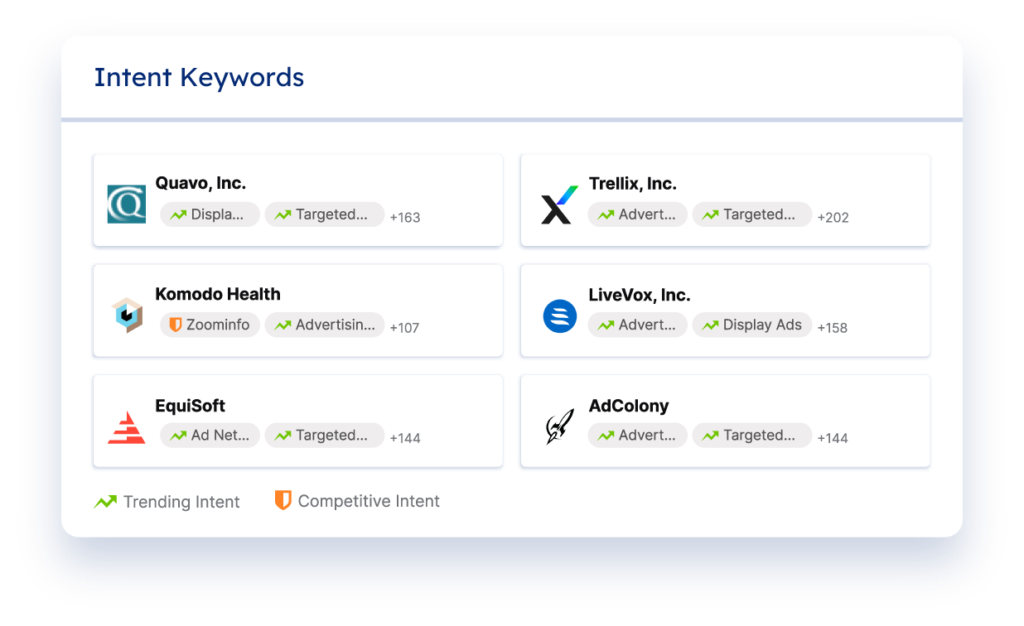
You can set up Demandbase Intent to help you identify prospects who show interest in your products, services, or those of your competitors.
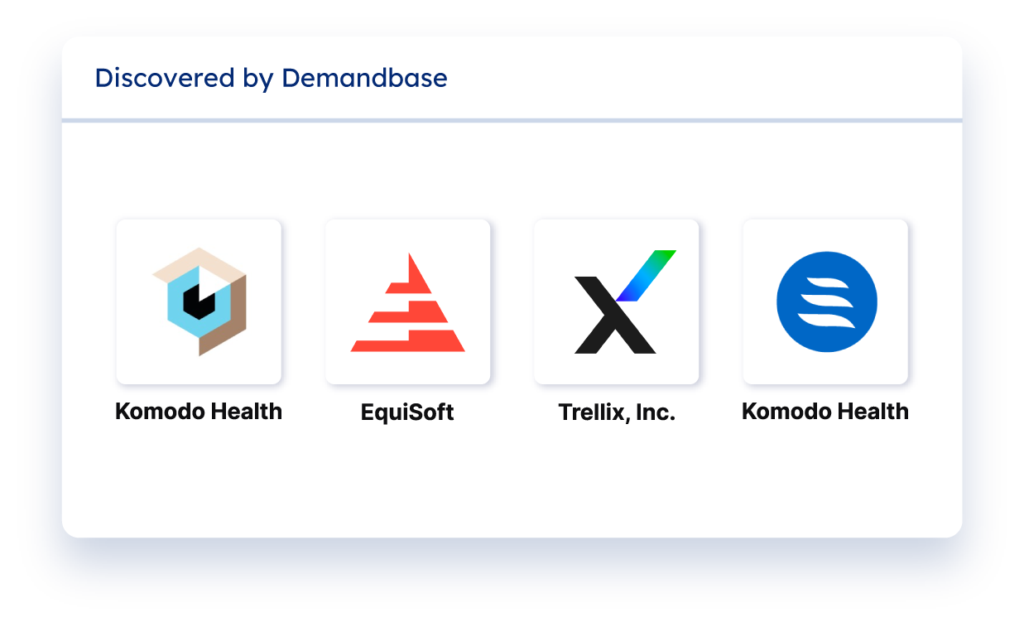
There’s also the ‘Discovered by Demandbase’ section that shows you net new accounts that you may want to target based on their Qualification Score, web activity, or intent strength.
Segment Accounts for Targeted ABM Engagement
Not every high-priority account should be treated the same way. Some require personalized one-on-one outreach, while others benefit from other scaled marketing efforts.
Segmentation ensures you match your outreach strategy to the account’s potential and level in the sales cycle.
Action plan:
To effectively segment accounts, follow a three-tiered framework that aligns outreach intensity with account potential.
Tier 1: High-Fit, High-Intent, High-Engagement (1:1 ABM)
These are your best-fit accounts, already showing strong intent and engagement signals. They deserve a hyper-personalized, high-touch approach.
Characteristics:
- Strong ICP match (perfect fit for your solution).
- Demonstrated purchase intent (engaging with sales, researching competitors).
- Multiple decision-makers involved (buying committee identified).
ABM Strategy:
- Dedicated SDRs or account reps assigned.
- Personalized outreach (custom emails, 1:1 LinkedIn messages, executive calls).
- Custom content (account-specific case studies, personalized videos).
Example → A Fortune 500 healthcare provider showing multiple intent signals:
- CTO viewed your security whitepaper,
- IT Director downloaded integration specs, and
- Procurement team visited pricing pages.
This account needs immediate, personalized outreach.
Tier 2: High-Fit, Moderate Intent, Moderate Engagement (1:Few ABM)
These accounts fit your ICP well, but their intent signals are weaker, or engagement isn’t as deep yet. They require nurturing before becoming sales-ready.
Characteristics:
- Strong ICP fit, but intent signals are sporadic or early-stage.
- Limited or low-level engagement (a few page visits, some email opens).
- One or two decision-makers engaging, but no full buying committee identified.
ABM Strategy:
- Segmented outreach (grouped by industry, use case, or company size).
- Personalized email sequences (use case-driven messaging).
- Targeted ads & retargeting (display and LinkedIn ads based on browsing behavior).
- Educational content & webinars (nurture through thought leadership).
Example → A mid-size fintech company where the Head of Operations regularly reads your blog content and attended a webinar, but no other stakeholders are engaged yet.
This account needs nurturing with industry-specific content.
Tier 3: High-Fit, Low Intent, Low Engagement (1:Many ABM)
These accounts fit your ICP but aren’t showing strong buying signals yet. They’re long-term plays, requiring a scaled, brand-awareness-driven approach.
Characteristics:
- Strong ICP match, but no clear intent or engagement signals yet.
- No significant decision-maker involvement.
- Early-stage interest (some content downloads but no real buying signals).
ABM Strategy:
- Scaled marketing campaigns (automated email nurtures, blog syndication).
- Broad awareness campaigns (podcasts, social media, content marketing, ABM ads).
- Soft engagement tactics (invites to industry events, social selling).
- Surge monitoring (track for future intent spikes and move to Tier 2).
Example → A growing SaaS company that fits your ICP perfectly but only has occasional blog visits from junior team members.
This account needs broad awareness campaigns until it shows stronger intent.
DB Insider → Implement a system to track account movement between tiers.
If a Tier 3 account suddenly shows multiple stakeholders engaging within 2 weeks, auto-flag it for tier promotion review.
On the flip side, if a Tier 1 account’s engagement drops for 30+ days, consider downgrading to preserve resources.
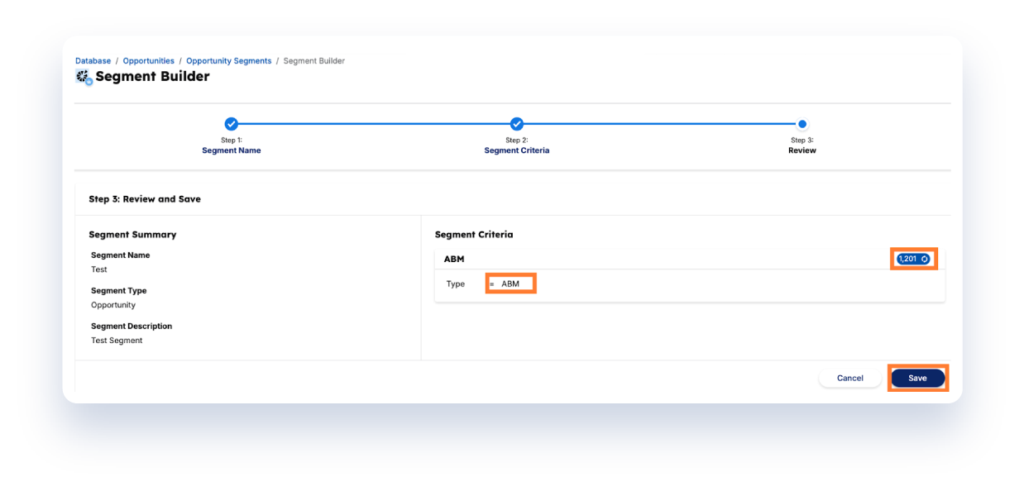
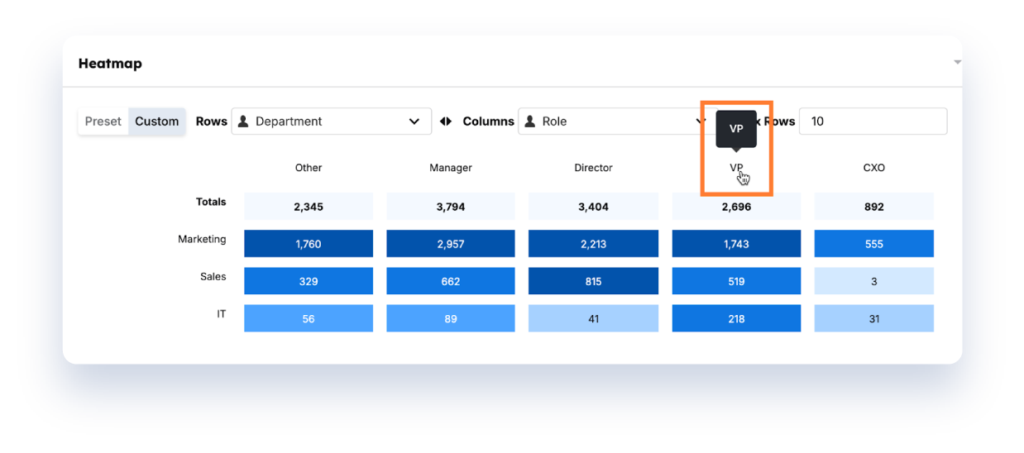

You can map People or Account Segments you create in Demandbase to custom fields you create in CRM. There’s also the ‘Heatmap’ feature to filter the data based on defined criteria.
Evaluate Account Readiness & Internal Dynamics
Even if an account fits your ICP and shows high intent, successful account selection also depends on internal readiness. Many ABM programs waste time on accounts that appear ideal but lack the internal conditions necessary to move forward.
Action plan:
Identify Internal & External Buying Triggers
What signals indicate an account is moving into an active buying cycle?
- Leadership changes: A new CMO or CIO often leads to new technology investments.
- Mergers & acquisitions: Newly merged companies need new tools to integrate operations.
- Funding rounds: Recently funded startups are actively scaling their tech stack.
- Compliance or industry shifts: Regulatory changes may force companies to adopt new solutions.
Map Out the Buying Committee & Key Decision-Makers
Most B2B deals involve 6-10 stakeholders, which is why targeting just one person won’t get the deal closed.
How to identify key stakeholders:
- Decision-makers: Who controls the budget and approves purchases? (C-suite, VPs).
- Influencers: Who conducts research and makes recommendations? (Directors, Managers).
- End users: Who will actually use the solution daily? (Operations, Specialists).
- Blockers: Who could stall or oppose the deal? (IT, Legal, Finance).
Score Readiness Level
Use a readiness score to filter out accounts that may be interested but lack the internal capability to execute a purchase.
Here’s a scoring example:
- 80-100 points: Highly ready (Clear budget, engaged buying committee, active buying triggers).
- 50-79 points: Moderate readiness (Some engaged stakeholders, but budget or timing unclear).
- Below 50 points: Low readiness (Passive interest, no internal urgency).
DB Insider → Create a budget cycle calendar by industry.
Many companies make major purchasing decisions at predictable times.
For example, healthcare companies often buy in Q4 before budget expires, education purchases peak in Q2 before academic years, and tech companies frequently spend in January when new budgets release.
Time your outreach 2-3 months before these windows when budgets are being planned.

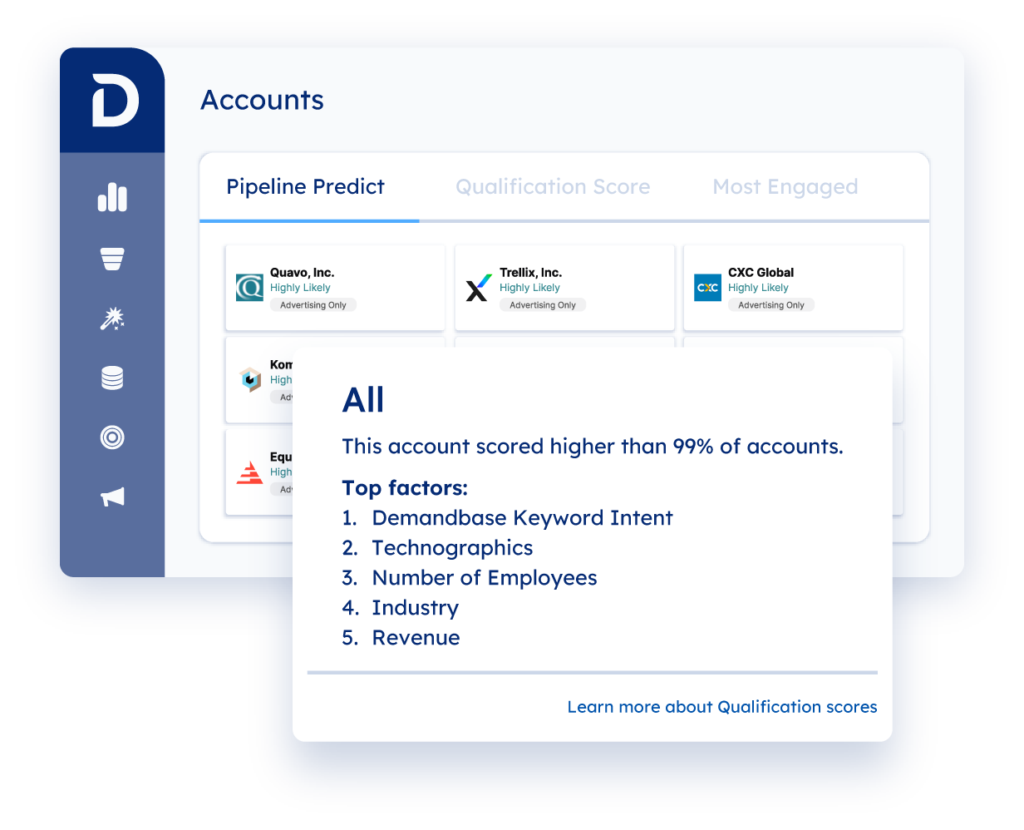
The Pipeline Predict Score indicates how likely an account is to become a pipeline opportunity in the near future.
Align Sales & Marketing for Seamless Execution
Both your sales and marketing teams must work together to identify, engage, and convert high-value accounts. Without alignment, marketing may generate leads that sales can’t close, while sales may chase accounts that don’t match the ICP.
Action plan:
Build a Shared Account Selection Framework
Marketing and sales must jointly define what makes an account ABM-worthy, as this eliminates disagreements and wasted effort. Here’s what both teams must align on:
- Target account criteria: What signals qualify an account for ABM?
- Engagement thresholds: When is an account “warm” enough for sales?
- Handoff process: How and when does marketing transition accounts to sales?
Best practice → Set up a weekly ABM account review meeting where marketing and sales refine target leads together.
Use a Unified ABM Dashboard for Full Visibility
Marketing needs to see how sales is engaging, and sales needs to know which accounts are showing intent. Here’s what to track:
- Active target accounts and their engagement scores.
- Real-time intent data (e.g., competitor research, high-intent searches).
- Sales interactions and pipeline movement.
- Marketing touchpoints (email engagement, ad clicks, content downloads).
The aim is to ensure both teams work with the same data, reducing friction and improving efficiency.
Define Clear Sales & Marketing Engagement Triggers
One of the biggest mistakes in ABM is engaging accounts too soon or too late. You need to maintain a balance.
- Early-stage engagement (Marketing-led): Brand awareness, content nurturing.
- Mid-stage engagement (Marketing & Sales collaboration): SDRs warm them up while marketing reinforces interest.
- Late-stage engagement (Sales-led): Personalized sales outreach, custom offers.
Establish Shared Success Metrics
With both teams focused on one goal, it’s easier to pinpoint what’s useful and what’s not. For example, you can define joint success metrics like:
- Account engagement score: Tracks all touchpoints (marketing + sales).
- Pipeline velocity: How quickly target accounts move through deal stages.
- Conversion rates by ABM tier: How Tier 1, 2, and 3 accounts perform.
- Revenue influence: How much pipeline and closed revenue came from ABM efforts.
DB Insider → Create a shared list of target accounts where both teams contribute insights on priority deals.
For example, you can set a threshold (e.g., deals >$50K) and have both teams contribute insights before major outreach.
This ensures alignment on messaging, tactics, and resource allocation for your most important opportunities.
Related → B2B Sales & Marketing Alignment: 7 Timeless Strategies for Growth in 2025
Test & Validate Account Selection with Pilot Campaigns
Before rolling out your ABM strategy at full scale, test and refine it with a controlled pilot. This ensures you’re targeting the right accounts with the right messaging and engagement tactics.
Action plan:
Select a Test Group of High-Potential Accounts
Instead of launching ABM across hundreds of accounts, start with a smaller, controlled group.
- Select 10-20 accounts across Tier 1 and Tier 2 segments.
- Include a mix of industries, company sizes, and engagement levels.
- Ensure accounts align with ICP and show clear intent signals.
Run a Multi-Channel ABM Campaign
The goal of the pilot is to test outreach methods, messaging, and engagement triggers to see what resonates best with your audience.
- Email outreach: Test personalized messaging for different buyer personas (decision-makers vs. influencers).
- Ad campaigns: Run targeted LinkedIn or display ads to measure engagement and click-through rates.
- Sales follow-ups: Use direct calls or LinkedIn connections to test response rates.
- Content engagement: Monitor interactions with industry reports, case studies, and product demos.
Measure Results & Optimize Before Scaling
Your pilot campaign should provide data-backed insights on which accounts are the best fit and what engagement strategies work best.
- Track key metrics such as response rates, demo requests, meeting conversions, and pipeline influence.
- Identify patterns based on which accounts responded fastest. Which industries or job titles showed the most interest?
- Remove accounts with low engagement and double down on those showing strong conversion signals.
DB Insider → Use the “3-2-1 pilot method.”
- Select 3 accounts that perfectly match your ICP,
- 2 that are slightly outside but show strong intent, and
- 1 wild card with unique characteristics.
This different test group helps validate your assumptions and often reveals unexpected opportunities.

You can use Demandbase Campaign Builder to target specific accounts and buying groups.
Read Case Study → SAP Concur Increases Funnel Velocity by 4X Using Journey Stages to Personalize Web Experiences
Take Your ABM Strategy to the Next Level with Demandbase
You’ve done the hard work of building your target account list. Great start. But now comes the tricky part—turning that list into actual revenue.
For most B2B teams, this is where things start to get complicated.
- You’ve identified high-fit accounts, but how do you know which ones are actually in-market?
- You’ve got a list of company names, but who, specifically, should you be talking to?
- You’ve crafted messaging, but how do you ensure it resonates with the right decision-makers?
- You’re launching campaigns, but how do you track what’s working and what’s falling flat?
Demandbase Gives You the Answers
- See Who’s Ready Now. Demandbase automatically identifies high-intent accounts using AI-driven firmographic, technographic, and behavioral insights. Instead of sorting through static lists, you’ll know exactly which accounts are actively researching solutions like yours.
- Know Who to Talk To. Get straight to the right decision-makers with verified contact data and real-time engagement insights. Understand who’s involved in the buying process and what matters to them.
- Measure What Works. Track every interaction, across every channel, in one unified platform. See which tactics drive engagement, which accounts are warming up, and where to focus your efforts for the highest ROI.
Take Demandbase for a spin →
Watch how Tom Keefe, Principal GTM Expert, uses Demandbase to design specific journeys for different product lines, geographies, and even business units.
Want better ABM results?

We have updated our Privacy Notice. Please click here for details.

